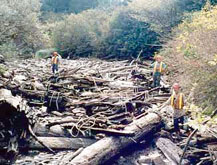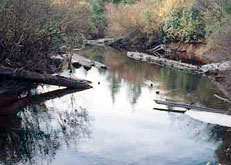page5
Parks Canada joins a partnership to heal Canada's temperate rainforest
The clear-cut forests and damaged creeks of the Clayoquot Sound ecosystem are being restored
On the West Coast of Canada, a massive rainforest drips with water and abounds with life. In Pacific Rim National Park Reserve of Canada, Parks Canada staff work to protect the ecological integrity of this special place, while still offering great adventures for visitors. Striking this balance is challenging, however, and cannot be accomplished alone. To safeguard the greater ecosystem surrounding Pacific Rim National Park Reserve, Parks Canada joined with the Central Westcoast Forest Society, International Forest Products (Interfor), and representatives from the public, First Nations and government on an ecosystem-based restoration project for the Kennedy Flats watershed in South Clayoquot Sound.
About mid-way between Ucluelet and Tofino on Vancouver Island, Kootowis Creek, Staghorn Creek and Lost Shoe Creek drain the low-lying area known as Kennedy Flats. Adjacent to the park, the Kennedy Flats watershed covers 129.4 square kilometres and drains through the park to the Pacific Ocean. Logging carried out before today's more rigorous controls were established had left Kennedy Flats and its creeks in a compromised position. Logging waste clogged the streams, blocking the passage of fish. Collapsed culverts and bridges had further degraded fish habitat and diverted segments of the creeks. Salmon production, which had once measured in the thousands in this area, had dropped significantly by the early 1990s.
The Kennedy Flats Restoration Project began with the hand-clearing of wood debris. To minimize the impact on the site, helicopters were used to remove wooden waste. However, cleaning up was only the first step; natural stream conditions had to be restored. Large logs or root balls were anchored into the stream to re-create natural pools and eddies. Gravel was added for spawning salmon, and plant cover for small fish.
 Creek before cleanup © Central Westcoast Forest Society |
Each year since 1995 (when the Central Westcoast Forest Society began restoration work in the area), a few more kilometres of streams and creeks were cleared, clear-cut slopes were stabilized, and more old roads were closed down. The restoration plan for the Kennedy Flats takes a comprehensive and coordinated approach to restoring both the aquatic and terrestrial ecosystems. The Society describes its activities as "giving Mother Nature a boost; accelerating the natural healing process". In 2005, positive results are being seen.
The work has already improved fish access through the removal of logjams that had been obstructing their passage. Creeks, streams and surrounding forests have been made healthier due to better-defined creek channels, more overhead cover and reduced flooding of the riparian zone (the 30 to 50 metres of land along each side of a stream). Work on the project has also had positive impacts on humans, providing unique training and stewardship opportunities for displaced fishers, forestry workers and local First Nations.
Plans call for further work inside as well as outside of the Pacific Rim National Park Reserve. Parks Canada is supporting the restoration of riparian slope stability to keep sediment from collecting in fish creeks for portions of Lost Shoe Creek within the park. Fisheries Renewal BC is funding the work planning through the Regional Aquatic Management Society. With funding help from Fisheries Renewal BC and Environment Canada's EcoAction Community Program, work began in 2001 to restore segments of Sandhill Creek within the park.
 Creek after cleanup © Central Westcoast Forest Society |
The ecosystem is not bound by park borders. Increased ecological integrity on one side of the park border means increased ecological integrity on the other. Just as creeks flow heedless of borders, effective restoration efforts cannot be confined by human boundaries. Collaborative restoration efforts, such as the Kennedy Flats Restoration Project, benefit us all.
Results
- Over 16 kilometres of streams have been restored, permitting salmon to return to former spawning beds and restoring flooded land to its natural state.
- In 1994, salmon returns for Kennedy Flats were less than 10,000 adult salmon. In 2004, the Tofino Stream Enhancement Society reported the best year ever with between 40,000 and 50,000 returned adult salmon.
- The habitat improved in 2000 alone could produce 122,000 Coho fry based on Department of Fisheries and Oceans standards.
- A five-kilometre walking trail and a longer 16-kilometre driving loop allow visitors to view portions of the restored streams.
- The success of the Kennedy Flats Restoration Project sets a standard for future ecosystem-based management efforts.
- Date modified :